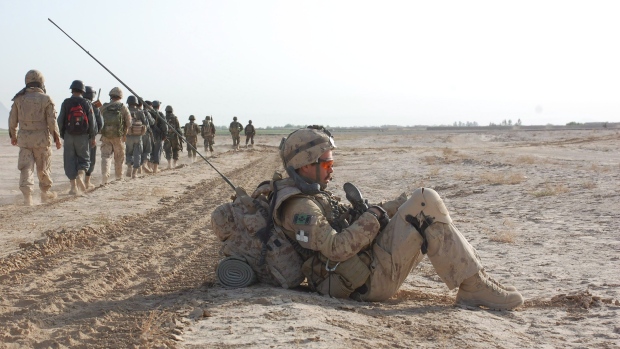
OTTAWA — Canadian troops will begin a phased withdrawal from Afghanistan next month, leaving fewer than 100 soldiers on the ground by the time the training mission officially comes to end in March.
But questions remain about whether the Afghan force Canadians have been training will be capable of fending off the continued onslaught of insurgents.
Maj.-Gen. Dean Milner, who’s in charge of Canadian troops and is deputy commander of the NATO training mission, expressed confidence the Afghan National Army and police will be able to meet the challenges.
“The Afghans, as you know, are 100 per cent in the lead. So there’s no doubt in my mind they’re taking more casualties,” he said in a conference call from Kabul.
Despite that, he said, there is “nothing that is precluding them from defeating the Taliban.”
But U.S. Gen. Joseph Dunford, Milner’s boss and the NATO commander in Afghanistan, said in a recent interview with the British media he believes Afghan forces are suffering an “unsustainable” level of casualties and that the fledgling army might need western help for another five years.
Milner says trainers have been working to mitigate the threats against Afghan troops by providing more extensive training for avoiding and diffusing roadside bombs and booby traps.
“The Afghans are putting a big focus on that,” he said. “Their confidence is growing.”
Canadian troops, who fought a five-year counter-insurgency war in southern Afghanistan, have been training Afghan military instructors and providing basic literacy courses at camps around Kabul, and in the northern part of the country, since the summer of 2011.
Milner said he visits Kandahar frequently and the region is now more stable.
The phased withdrawal of some 950 Canadian trainers will take place throughout the fall.
A recent study by a respected Washington-based think-tank paints an ominous portrait of the increasingly violent war NATO is leaving the Afghans to fight.
The Centre for Strategic and International Studies, citing U.S. Defence Department data, noted there has been no drop in the number of insurgent-instigated attacks this year compared with last year.
Unlike the U.S. experience in Iraq, the surge of troops into Afghanistan did not produce a gradual reduction in violence, said the report.
“I think you simply have to say this is still a very violent war,” Anthony Cordesman, the report’s author, said in an interview.
Up to 100 Afghan soldiers are killed in battle every week, according to new figures from NATO.
Milner praised the buildup of Afghan security forces to the current 345,000, but Cordesman’s report noted that roughly half of that is actual fighting strength and the country remains heavily dependant on local militias.
Experts have long been concerned that once NATO withdraws at the end of next year, funding to sustain such a large Afghan army will dry up.
But Milner said Canada remains committed to contributing toward Afghan security.
Critical military hardware, such as helicopters and communications equipment, remain in short supply, said the think-tank.
Recent reports from the region suggest India, which has been negotiating a defence alliance with the Afghanistan government, has signalled it is prepared to fund vehicles and helicopters, but not weaponry.
The U.S. and Afghanistan have still not settled on the legal status of American forces that will remain in the country beyond 2014.








